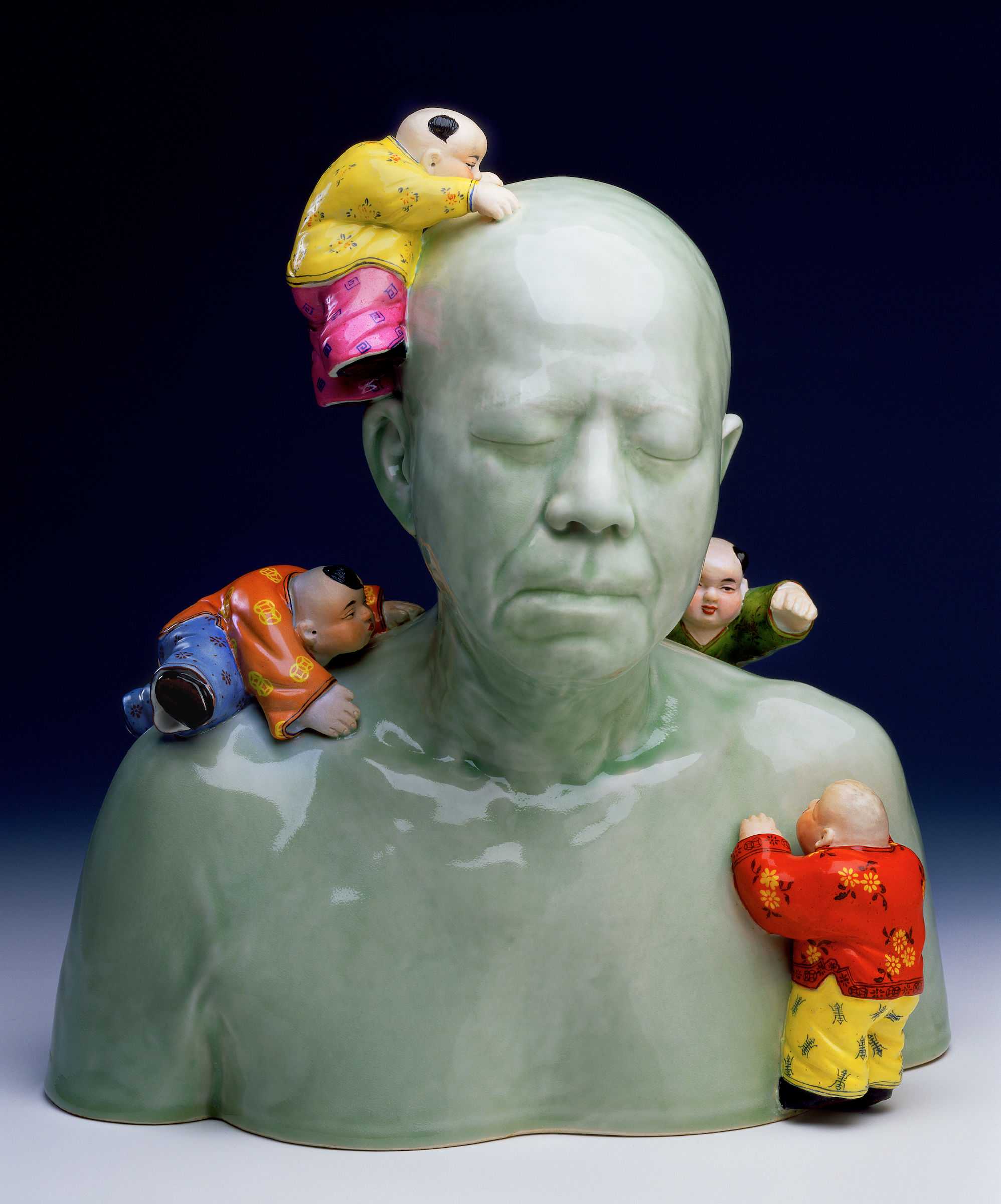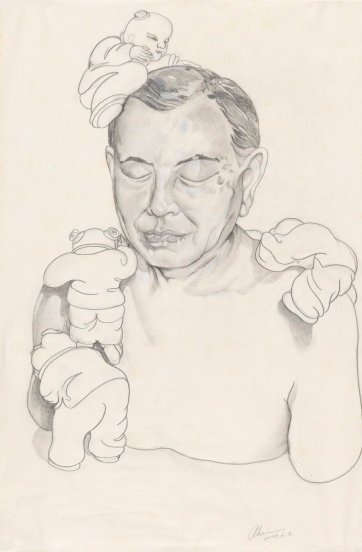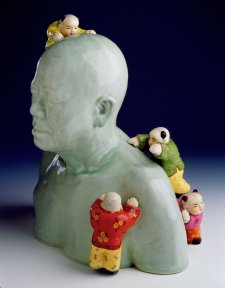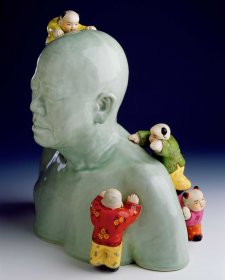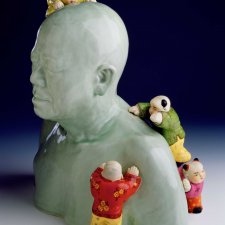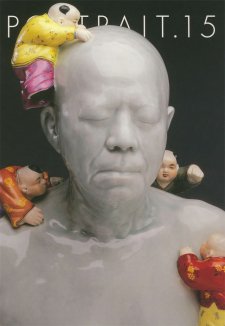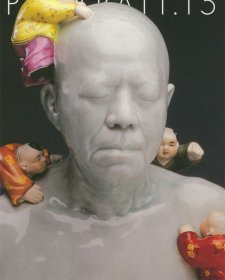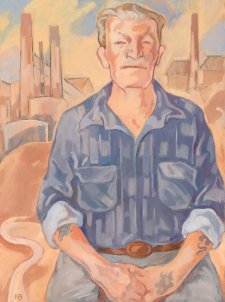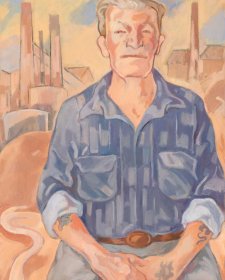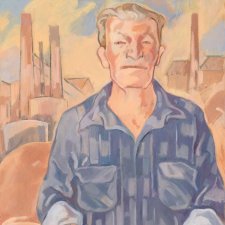Australian of the Year in 1996, paediatrician and administrator Dr John Yu AC has a strong association with children's health, medicine, education and the arts. His portrait, commissioned by the National Portrait Gallery, reflects his heritage and interests, and introduces the first 21st century porcelain bust into the collection.
Born in Nanking, China, John Yu moved to Australia with his parents at the age of three. A graduate in Medicine from the University of Sydney, for 19 years he was the Chief Executive of the Royal Alexandra Hospital for Children in Sydney. Over the course of his distinguished career he has been the inaugural Chair of the Specialist Advisory Committee of the NSW Commission for Children and Young People, Chair of the Australia-China Council, and Chancellor of the University of New South Wales. Noted for his collection of Chinese ceramics and love of art and music, he is currently Vice President of the Board of the Art Gallery of New South Wales.
The Gallery had discussed a portrait of John Yu for some time, but it was not until Sydney-based artist Ah Xian won the National Gallery of Australia's inaugural National Sculpture Prize with a life size cloisonné enamel figure that ideas of a truly fitting portrait of John Yu crystallised.
For Ah Xian (pronounced Ah-shyan) it was the first commission of a dynamic career. Born Liu Ji Xian in 1960 in Beijing, he taught himself art and by the 1980s, known as Ah Xian, he was a professional artist in the Chinese capital.
He first visited Australia in 1989. Following the calamity of Tiananmen Square, he sought political asylum in this country. His application for citizenship took many years and during this unsettled time he worked primarily as a house painter and kitchen-hand. In 1997, he started to do experiments in making porcelain bust casts in his backyard. Later, he was offered an opportunity to work as artist-in-residence at the Sydney College of the Arts for one year. In 1999, with the aid of an Australia Council grant, he went back to China and began working with Chinese craftsmen in the well known porcelain town of Jingdezhen making porcelain busts decorated with traditional Chinese designs. Over the ensuing years Ah Xian has created busts and full size figures in red lacquer and cloisonné, elaborately inlaid pieces with jade and Ox-bone, bronze figures with typical ancient Chinese bronze decorations, all based on age-old methods of craftsmanship.
When he was approached to undertake the project towards the end of 2001, Ah Xian was hesitant. He had never worked on commission, and he was concerned about the possible breakage of the porcelain bust at various stages of the manufacturing process, involving clay, water and fire. The complex process of the commission would make it time consuming and expensive. Also, he was unsure of gaining a likeness. The National Portrait Gallery Board had contemplated the commissioning of a cloisonné bust in welded copper with rich enamelling, but the more he thought about the project, the more convinced Ah Xian became that porcelain would deliver a better likeness. Once he met John Yu the artist's hesitations vanished and he quickly embraced the possibilities of the project. He found John to be 'kind and gentle' and gained a strong sense of his awareness of Chinese culture and his love of the arts. The pair agreed to meetagain, this time to make the necessary plaster cast of John's head and shoulders.
The design Ah Xian conceived was based on a celadon bust of John, depicted life-size with a number of colourful miniature children climbing upon him. In traditional Chinese lore many children indicate great prosperity and happiness, and the concept for the bust was informed by the Chinese tradition of children, 'Tong Zi' clambering over the Laughing Buddha. Ah Xian said 'I believe that this design will confirm Chinese traditions as part of John's and my cultural background, the characteristic way I make my works, and John's joy and passion of collecting ceramic vessels especially celadon ... also it will confirm John's close relationship with children through his career'.
In March 2002, the Portrait Gallery Board viewed a pencil sketch of the proposed work. With the support of the Gallery's Chair, Marilyn Darling, the most expensive portrait commission to date was unanimously approved, and the project was given over to Ah Xian to complete.
For John Yu, the cast making process was more arduous than expected. Wrapped in cling wrap to his waist, he had to endure the painstaking applications of plaster bandages around his face and chest. As they applied the plaster, Ah Xian and his wife Ma Li Hong made holes to ensure that John could continue to breathe.
For the next step in the casting, Ah Xian planned to take the moulds to China, to work with the craftsmen at the ancient porcelain kilns at Jingdezhen with whom he had collaborated since 1999. In Jingdezhen the craftsmen would help Ah Xian to make the porcelain 'positive' of the bust and perform the firings of the ceramic head. Work was progressing well when there was an unexpected delay: the outbreak of Severe Acute Respiratory Syndrome (SARS) in China. For the time being, Ah Xian was forced to abandon his proposed travel to his homeland.
Months passed with Ah Xian keeping in contact with the Gallery over the slow progress of the work, due to a combination of circumstances including his busy schedule of exhibitions and his reliance on the craftsmen employed to undertake many of the technical processes of the bust. Just when the Gallery was beginning to wonder if the long awaited bust would ever be finished, a jubilant Ah Xian arrived back in Australia with the completed bust in his luggage. The fragile bust arrived at the Gallery in December, on the morning of the last Board meeting of 2004. It had taken nearly three years from the initial idea to the completed object, but when presented to the Board it was welcomed with enthusiasm.
The finished work gleams under its glassy celadon glaze. The figure of John Yu is frozen as if asleep or in deep meditation, oblivious of the crowd of colourful children scrambling over him. Ah Xian often uses contrasts and juxtapositions in his work, usually in the patterning. In this work, there is a striking absence of pattern, allowing a strong contrast between the figure of the physician and the colourful images of the impish children. 'I hope to make contrast and tension between the completely celadon bust of John Yu and colourful little children climbing around him', says the artist, 'and yet have great harmony as well'.
Ah Xian's bust is only the second portrait in the collection display that depicts the subject with his eyes shut; the other is the death mask of bushranger Ned Kelly. Obviously the process of making the plaster mould, uncomfortable enough already, requires the eyes of the living subject to be closed. The methods involved in Ah Xian's work parallel those employed in the creation of death masks, but the finished objects are worlds apart in intention and effect. Although the 'windows to the soul' - the portraitist's great device - are closed, the bust of John Yu is imbued with a dignified presence. The beautiful work resonates with composed and calm humanity, touched with humour. Our twentieth commissioned portrait was well worth waiting for.
